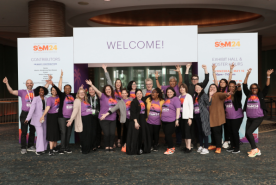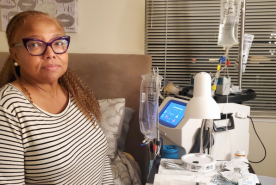July 18, 2022
Ann Pittaoulis, RD, LDN
Despite continuous efforts to educate on CKD, many patients starting dialysis in the United States still are not aware of, or understand, dialysis. Patients and families may not even understand the options of modalities. Crashing on dialysis is an overwhelming experience that doesn’t have to occur; however, unfortunately, it does. New patients to dialysis are likely to start dialysis with a central venous catheter. In fact, that accounts for about 80% of all patients when they start dialysis. They have a high risk of hospitalization, high risk of mortality, and they utilize health care resources for the first year they're on dialysis in a significant way.1
According to the most recent statistics, 15% of the US population have kidney disease. Despite the prevalence of CKD, the majority don’t know they even have kidney disease. Less than 20% with CKD stage 3 know they have it, which is the largest population of CKD patients. At stage 4, only about 60% are aware and at stage 5, when patients need dialysis, there are still many that are unaware. Thus, when patients develop kidney failure and end-stage kidney disease, they're in need of emotional support. They are forced to cope with a diagnosis of renal failure. Therefore, they need education on their options and better medical management. One promising answer to this need is the Transitional Care Units (TCUs). A TCU provides that emotional support, allows for coordination of care, as well as provides patient and family education and support.1
In the broadest sense, transitional care refers to coordination and continuity of health care during passage from one care setting to another. In simple terms, a good example of transitional care would be coordination of care when a patient moves from a hospital setting to a skilled nursing facility. This concept has also been applied in patients with chronic kidney disease, where a patient is transitioning into stage 5 kidney disease and will require dialysis.
A TCU works on providing emotional support for the patient, and educating the patient on the disease. TCUs allow the patient to make the decision on which modality of dialysis best suites them individually. Most patients, when they first are told they have kidney failure and need dialysis, assume that dialysis is extremely complicated and is technically challenging. There may be a general belief that it’s best for them to receive dialysis in a clinic under the care of a trained and experienced staff.
Inadequate patient education and decision-making support are the key barriers to patients choosing home-based therapy. Often when patients enter dialysis in an in-center unit, there is not adequate education for the new patient. Although dialysis providers may want to provide this training, there are many challenges to the dialysis providers to provide this training adequately. This includes development and optimal delivery of education materials, appropriate staffing and training;2 a TCU would allow this.
It is well documented that home hemodialysis (HHD) and peritoneal dialysis (PD) are associated with better clinical outcomes, lower hospitalization rates, and improved quality of life compared with conventional in-center hemodialysis. However, in the US still less than <12% of patients requiring dialysis use the home dialysis (HHD or PD). When surveyed, over 90% of nephrologists would choose home-based dialysis modalities for themselves.2 According to Dr. David E. Henner, who presented on Transitional Care Units just recently at the NKF’s 2022 Spring Clinical Meetings, there is still a significant lack of CKD education. Why do they need this education? The prevalence of ESKD is still climbing and CKD 5 has steadily been increasing. He acknowledged there was a little decline in 2020 and 2021; most likely due to COVID- either because patients were lost or they were not seeking care. However, there has been an explosion in last few months that will soon be available in the Renal Data report.3
Dr. Henner, like many of his colleagues, agree that the best treatment next to preemptive transplant is home therapies; either HHD or PD. He goes on to say that most patients when they crash into an in-center unit are never given the choice of any other modality.
A survey by one of the ESRD Networks showed
- 66% were NOT presented the option of PD
- 88% were not presented the option of HHD
- 74% were not presented the option of transplantation4
One of the goals of the TCU is to change these statistics.
One of the other major reasons there has been a push for home dialysis, other than the fact that outcomes are better, is because in July of 2019, President Trump signed an executive order directing the Department of Health and Human Services to develop policies addressing ESKD in the US. There were 3 main goals:
1.Reduce the number of Americans developing ESKD by 25% by 2030
2.80% of new ESKD patients in 2025 receiving dialysis at home or receiving a transplant
3.Double the number of kidneys available for transplant by 2030
Behind all of these are initiatives include a payment model.5 Many KOP leaders in nephrology believe this is a very challenging goal. TCUs are designed to encourage home dialysis and may play a key role in trying to reach these goals.
History of the TCU
The first known transitional unit was established as the “Dialysis Orientation Unit” at Northwest Kidney Center by Dr. Joel Eschback in 1981. The orientation unit provided a 2-month stabilization program emphasizing modality, diet education, patient “rehabilitation,” and transitioning safely to home dialysis. Historically, Northwest Kidney had a low rate of patients choosing home modalities, but their 1-year outcome showed that a striking 62% of the patients transitioned to the home dialysis unit. Even as more complex patients entered their unit, they were able to maintain a 25% uptake rate of home therapies in the mid-1990s.6
In the 2000s, large United States-based dialysis providers initiated dedicated quality improvement programs targeting incident patients. Although these programs included many elements of the TCU model, they did not use a separate physical plant component, but rather, were in-center. Improvements were observed, such as access placement rates, hospitalizations, and mortality. Although modality education was a component of these programs, the effects on home therapy uptake were not reported.7
In December 2016, a group of medical providers interested in improving patient outcomes formed the Transitional Care Demonstration Initiative Work Group to outline the model of an effective TCP. They were also concerned for the majority of patients who crashed into dialysis and/or did not receive adequate education prior to their dialysis start. The goals for the work group included the following:
- Providing increased access to nurses and other members of the care team to help promote trusting relationships between the patient and the care team and answer any patient questions.
- Educating in depth on all modalities, including in-center hemodialysis, home hemodialysis, peritoneal dialysis and kidney transplantation. The patient should be informed that different modalities will likely be required at different times over the duration of care.
- Developing an individualized care plan based on each patient’s needs, goals and home environment. This effort requires shared-decision making between physician and patient.
- Offering patients self-care training and hands-on experience with different dialysis modalities.
- Stabilizing patients, which sometimes requires providing more-frequent, gentler dialysis treatments during the first few days and adjusting medications, target weights and diets as needed.8
Today in the United States, TCUs are just beginning to take root. Some data is available however most is anecdotal. One such program was at Satellite Dialysis, termed “Optimal Transitions.” The Satellite Healthcare Optimal Transitions (OT) Program was developed to provide education and decision support to patients during the transitional period. OT provides in-depth education in all dialysis modalities at the start of dialysis over a flexible time period. This is typically 1-4 weeks, and is adapted for various learning curves to allow for time for physical stabilization, self-care training, and modality choice based on each patient's individual life motivations, goals, and environments. Their TCU uses traditional education and psychosocial support program pillars but added a new element—a 5-day per week dialysis schedule using home dialysis machines to provide a gentler break-in experience.7 The program resulted in increased patient confidence to execute home dialysis with the potential for improved patient outcomes, and reduced hospitalizations.4
Transitional care programs around the world
In the United Kingdom, Canada and the United States, transitional dialysis—and components of transitional dialysis—have started to emerge with promising results, including the following:
- Grand River Hospital (in Ontario, Canada) launched the Right Start Unit for incident dialysis patients in 2009. In the unit, patients in the unit (typically those who crash into dialysis) are comprehensively educated on kidney disease and dialysis, and are often able to receive dialysis at home. Patients in a study group experienced a 22 percent greater reduction in mortality risk and an 8 percent reduction in hospital readmissions than a matched cohort.6
- Renal Ventures Management developed the Coaching for Actions, Results and Empowerment program (RVCARE) in 2010 which focuses on education, better access, volume management, nutritional status and transitioning patients to the dialysis modality of their choice within the first 120 days of dialysis. About 25% of their patients had transitioned to home within 120 days, as compared to 13% at the start of the program. There was a four-fold increase in peritoneal dialysis therapy uptake than reported averages and dramatic reductions in mortality.6,9
- The United Kingdom developed the Shared Haemodialysis Care model in 2011 in which the care team helps patients become more involved with their own treatments. As active participants in their care, patients learn how to take their blood pressure, program their own machine and perform other dialysis functions.6
Types of Transitional Units
There are essentially two types of TCUs, either in-center within an established operating unit or a separate standalone unit.
The first type, the integrated TCU is in-center at an established HD unit. The TCU may be next to the in-center unit or in a separate pod on the floor. HD machines may be traditional in-center dialysis units or a smaller home unit, like the NxStage, depending on the provider.
Advantages include:
- Staffing will also be learning about TCU and are more readily available to provide services to the new patient
- There is more exposure to in-center treatment so potential patients can see what it is like inside the center
- It is typically less expensive for the unit to operate since it does not require a whole lot of extra staffing or approval for new unit
- Can be a deciding factor in the choice of modality
- Usually starts with an in-center dialysis machine
Disadvantages include:
- Patients never gain a sense they can do it alone
- Can be traumatizing with all the alarms and activity
The other type of TCU would be an entirely separate unit. This is a stand-alone unit usually affiliated with a home program training unit.
Advantages include:
- Quieter, less chaotic, more controlled setting
- Patients are less likely to start in-center
- There are dedicated staff which may mean more flexible times
- Care givers can join in a more relaxed setting
Disadvantages include:
- Never get a sense what an in-center unit is really like
- More costly for the facilities to maintain
Regardless if the transitional unit is in a center or freestanding, the benefits of having them for the patients sets the stage for a “better educational experience for the vulnerable patient” per Dr. Bett who is the Medical Director of a Transitional DaVita unit in Lancaster, PA. I had an opportunity to meet and speak with Nancy Manley, RD the dietitian for the unit since its inception a few years ago. She also covers the in-center and some of the Home program patients in the same building. All three, Home, In-Center and TCU, are all considered three separate units, even though they are all contained in the same building. She commented “Since these patients do require more of your time, it can be challenging when you are responsible for all your other duties and patients.” The TCU originally started with Nxstage machines, but they are now using regular machine and the patients come in 3x a week and dialyze anywhere from three to four hours. Dr. Bett reported that of the 115 patients that have gone through the program, 34.1% have chosen a home modality – 7 to HHD and 33 to PD. When asked what improvements are needed, she said “consistent staffing.” Jen Vozzella, the unit’s social worker, finds it rewarding but challenging. Her time is also split with the in-center and Home Program. She believes that even though home is being encouraged, many of her patients will still remain in-center. However, they are more content since they are making their own decision.
What patients are considered for transitional units?
According to Dr. Dinesh Chatoth, Associate Chief Medical Officer of Fresenius Kidney Care, “most new patients” are considered for transitional units. He believes in the importance of “comprehensive, hands-on education that is individualized for each patient, empowering them to manage their own care.”
Others who could benefit from the program include:1
- In-center HD patients interested in or ready for home dialysis
- PD patients who need to change modalities due to ineffective therapy
- Patients returning to dialysis after a failed kidney transplant
Patients who would not be considered for transitional units include:3
- Acute patients would not be considered for transitional unit
- Nursing Home patients whose facility would not offer a home dialysis program
- Patients that are not able to comprehend the education or are not capable of making a decision to select the modality without a dedicated caregiver
There are numerous selected dialysis centers nationwide that now provide TCUs. Fresenius Medical Care (FMC), DaVita, and other independent units have opened these centers and physicians can refer patients to a TCU when they need to start dialysis and do not have a planned start. In June of 2020, FMC announced they would be opening 100 new TCUs.1 DaVita also has both in-center and free-standing TCUs as well as many independent centers.
Most TCUs incorporate one-on-one education as well as literature that is reviewed by the different disciplines. These can include short videos, or demonstrations all with suggested times and the specific order and by which disciplines. Most of the education developed by Nxstage, FMC, DaVita and Independent units are taken from previous developed tools to assess the best modality for the patient. For example, one of the earlier tools was My Life, My Dialysis Choice. This tool is used to help the patient select the best modality. Most chain dialysis centers use a modified version of this in their training program; this helps the unit and patient determine the best modality for them.10 Another tool that was used was Method to Assess Treatment Choices for Home Dialysis (MATCH-D). This was developed by the non-profit Medical Education Institute, Inc., for Home Dialysis Central to help nephrologists and dialysis staff identify and assess candidates for home dialysis therapies (PD and HHD). It was designed to sensitize clinicians to key issues about who can use home dialysis.11
The current TCU model as recommended by the National Forum of Networks across the US also incorporates other topics and is typically spread across a 4-week period.12 The education provided includes:
- Initial Education- Rules and regulations, grievance policies
- Treatment modalities: HHD, PD, In-center
- Vascular access
- Transplantation
- Psycho-social issues
- Diet
- Financial Resources
Typical Roles of the team as recommended for a TCU:
- In-Center RN: oversees the TCU treatments, accesses the patient pre and post treatment, coordinates a vascular access path, administers medications, and provides education.
- Home Therapy RN: Provides in-depth education on PD and HHD modalities
- PCT/CCHT/LPN: Preforms the treatment and reinforces education provided by the RN
- Social Worker: Shares relevant financial information with patients on insurance coverage, entitlements as well as other economic aspects related to treatments. Assist in transplant referral as needed and provides emotional support to the patient and family.
- Renal Dietitian: Educates patients on their dietary and fluid requirements with regards to each modality.
- Physician: Prescribes therapy, adjusts medications and treatments based on the patient’s needs, reinforces education provided by the TCU team and informs the patient on data regarding survival and risks of each modality.
- Patient Financial Advisor: Advises patients on financial topics such as insurance, transportation, Medicaid/Medicare regulations (may be Social Worker)
The typical 4-week education plan can be adjusted based on the patient’s understanding and grasp of the knowledge. The first week helps patients cope with the changes in their lifestyle, assessing their medical needs and getting to know them as well as their support group; it may be a very involved time for the social worker. It was discovered early on that finances and insurance questions need to be discussed first and foremost before patients will be able to be attentive to the education on diet, fluid and modalities, and a patient needs to feel emotionally and psychologically supported. The second week focuses on teaching the patient about renal replacement therapies or modalities. The third week builds on and deepens this knowledge, whether dietary, fluid restrictions etc. In the last week, the patient and the care team put a plan together for the patient’s chosen modality and their transition out of the TDC unit.
A typical model of the education and breakdown can be found on the ESRD Network website.12,13 Typically the 4-week curriculum is as such:
Week 1: suggested Curriculum (170 minutes- includes one-on-one, reading, videos and questionnaires)
- Provide emotional support and comfort to the patient
- Determine if patient would like a family member involved in the educational process
- Briefly introduce how dialysis works
- Address patient/family member initial questions, fears & concerns
- Educate patient/family member on the cause of their ESRD
- Address preconceived ideas about dialysis & introduction to staff
- Assure patient their insurance will pay (Medicare, commercial, etc.)
Week 2: suggested Curriculum (285 minutes- includes one-on-one, reading, videos and questionnaires)
- Allow patient/family member to ask questions prior to week 2
- Educate on fluid, infection, and medication management
- Discuss patient short & long-term lifestyle goals
- Provide basic modality and access education: PD, HHD; transplant and in-center
- Present outcomes data, quality of life data
- Review Patient Insurance Benefits
- Introduce prospect of home dialysis (PD and HHD)
Week 3: suggested Curriculum (350 minutes- includes one-on-one, reading, videos and questionnaires)
- Allow patient/family member to ask questions prior to week 3
- In-depth education (including access) on: PD, HHD, In-Center, and Transplant
- Patient/family member discussion of modalities with a PD, HHD, In-Center, & Transplant patient
- Financial education regarding dialysis therapy (water consumption, transportation, etc.)
Week 4: suggested curriculum (175 minutes- includes one-on-one, reading, videos and questionnaires)
- Allow patient/family member to ask questions prior to week 4
- Determine patient’s modality preference
- Reassure patient/family member that all options remain available
- Teach patient/family member dietary restrictions (customized based on modality choice)
- If patient is interested in transplant, refer to appropriate transplant centers
- If patient chooses a home modality, refer them to helpful resources
Outcomes
A survey done by NxStage Medical Inc. on 60 patients graduating from one of 10 participating TCUs in the US between October 2018 and April 2019 showed that 70% of patients chose a home modality, with 25% choosing HHD and 45% opting for PD.13
The University of Virginia (UVA) Health System also runs a TCU and presented some outcomes at the 2022 NKF Spring Clinical Meetings. In the first year of operation of their TCU, they reported improved outcomes for the 17 patients in the program, including a significant decrease in dialysis-related hospitalizations and readmissions. They credit these improvements to the educational component of their program and the education by their core team. The UVA patients underwent dialysis four days a week for a total of 12 to 14 hours per week, using NxStage HHD machines.3
Kim Deaver, the Dialysis Administrator at UVA Health System Reported:
- A 22% reduction in adjusted all-cause mortality among Medicare fee for service (FFS) beneficiaries greater than or equal to 66 years of age with CKD
- A 29% reduction in the adjusted rate of all cause hospitalization among Medicare FFS beneficiaries 66 years of age or older with CKD
- A 14.5% reduction in readmission after hospitalization discharge among older Medicare FFS beneficiaries with CKD.
- An 85% increase in the percentage of incident dialysis patients starting home dialysis, and a 73% increase in the percentage of patients performing home dialysis one year after dialysis initiation.
- A 61% reduction in the rate of hospitalization for peritonitis and a 36% reduction in the rate of hospitalization for catheter complications among patients on PD
It is also well noted that the cost to CMS and insurance is 10-times greater during the initial transition period than at other times while a patient is on dialysis. Ultimately with an increase in appropriately run TDC units and CMS reporting, we should see a reduction in readmission rates, reduced hospitalization rates and improved quality incentive program measures that will prove cost effective.14
While the goal of a TCU is for more patients to choose home dialysis, it's important to recognize that if a patient chooses in-center dialysis, the belief is that those patients will have better clinical outcomes because of the education they received in a TCU. It is likely those patients would have timely placement of permanent vascular access, they would have better adherence to medication treatments, and they would be referred earlier for transplant.1
While an important part of the TCU is that patients can make informed decisions on their modality of choice as well as transplant, the next most important piece is to identify a support system so that the patients have support from family, friends, and/or other support groups despite the modality they choose.
When the patient is emotionally stable and understand what their goals are, they feel better and are clinically and medically more stable; they are educated so they can make an informed decision. Many believe TCUs are here to stay and are a better way for patients to start dialysis. Even though there may be a higher cost in maintaining a TCU, ultimately it may be cost effective, especially when hospitalizations, readmissions and healthcare costs are reduced overall. Thus, TCUs have the potential to save the healthcare system money. Perhaps after more data is collected from the existing TCUs, with more positive outcomes, the TCU will be an established path into dialysis.
References:
- America, Fresenius Medical Care North. “Fresenius Kidney Care Expands Transitional Care Units.” Fresenius Medical Care, Fresenius Medical Care, North America, 11 Apr. 2022 https://fmcna.com/company/our-company/news-releases/fkc-expands-network-of-transitional-care-units/.
- Morfín JA, Yang A, Wang E, Schiller B. Transitional dialysis care units: A new approach to increase home dialysis modality uptake and patient outcomes. Semin Dial. 2018 Jan;31(1):82-87. doi: 10.1111/sdi.12651. Epub 2017 Oct 5. PMID: 28983956.
- Henner, David E, and Deaver Kim. “Transitional Care Units.” (Conference Presentation) NKF Spring 2022 Clinical Meeting, April 9, 2022. https://cme.kidney.org/spa/courses/resource/2022-spring-clinical-meetin…
- Mehrotra, Rajnish, et al. “Patient Education and Access of ESRD Patients to Renal Replacement Therapies beyond in-Center Hemodialysis.” Kidney International, vol. 68, no. 1, 2005, pp. 378–390., https://doi.org/10.1111/j.1523-1755.2005.00453.x.
- National Archives and Records Administration, National Archives and Records Administration, https://trumpwhitehouse.archives.gov/presidential-actions/executive-order-advancing-american-kidney-health/.
- Singh, Namita. “Transitional Care Units: How Successful in Increasing Home Dialysis?” Seminars in Dialysis, vol. 34, no. 1, 2020, pp. 3–4., https://doi.org/10.1111/sdi.12910.
- Bowman BT. Transitional Care Units: Greater Than the Sum of Their Parts. Clin J Am Soc Nephrol. 2019 May 7;14(5):765-767. doi: 10.2215/CJN.12301018. Epub 2019 Mar 27. PMID: 30917994; PMCID: PMC6500944.
- “Potential Benefits of Transitional Care Programs for the Initial Days of Dialysis.” DaVita® Medical Insights, 7 Feb. 2019, https://blogs.davita.com/medical-insights/2018/05/08/potential-benefits-transitional-care-programs-initial-days-dialysis/.
- “Reddy N, Brooks K, Schmidt L, Parker 3rd TF. A Crucial Lifeline: Reducing Mortality in the First 120 Days. Nephrol News Issues. 2012;26:22-4-26-7.”
- “A Kidney Treatment Decision Aid.” My Life, My Dialysis Choice, https://mydialysischoice.org/.
- Daley, Matt. “Using the Match-D More Effectively to Increase Utilization of Home Therapies.” Home Dialysis Central, 5 Mar. 2020, https://homedialysis.org/news-and-research/blog/349-using-the-match-d-more-effectively-to-increase-utilization-of-home-therapies.
- Rev_C_TDC_Operational_Guidance. https://media.esrdnetworks.org/documents/APM2548_Rev_C_TDC_Operational_Guidance_PDF_FINAL.pdf.
- “Transitional Dialysis Care.” NxStage Medical Inc., https://www.nxstage.com/administrators/transitional-dialysis-care/.
- Alexander, Amanda. “Transitional Care Units Set Patients up for Successful Dialysis.” Nephrology News and Issues, 13 Mar. 2019.








